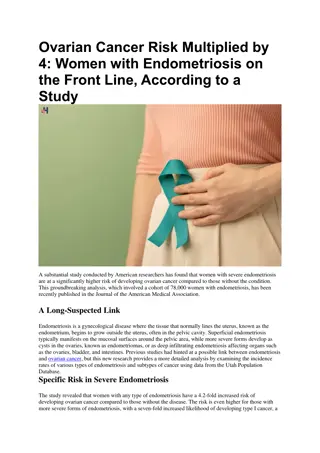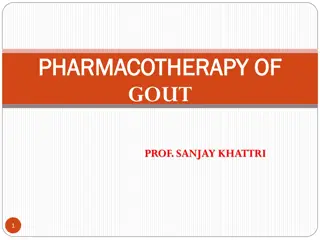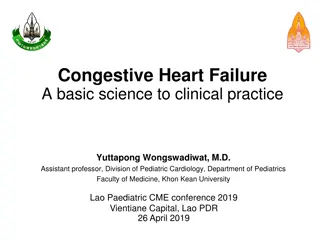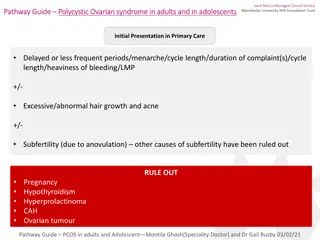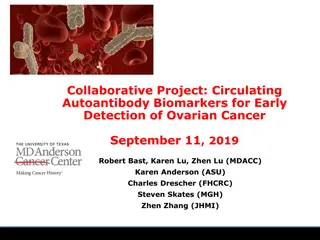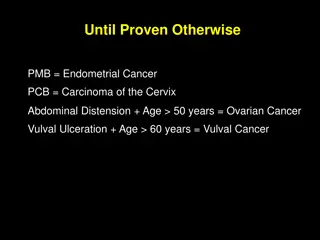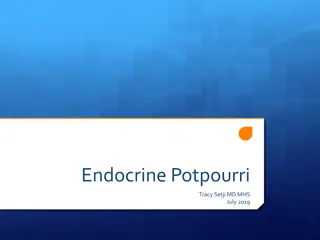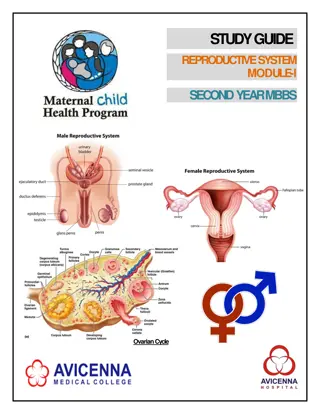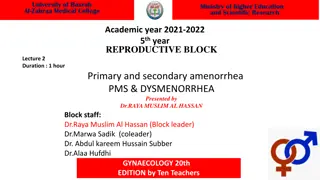Understanding Primary Ovarian Insufficiency: Definition, Pathophysiology, Clinical Features
Primary ovarian insufficiency, also known as hypergonadotropic amenorrhea, is a condition characterized by ovarian dysfunction in women under 40. It involves oligo/amenorrhea, elevated FSH levels, and impacts fertility and overall health. The pathophysiology includes follicle depletion and dysfunction, leading to unpredictable ovarian function. This condition carries physical and mental burdens, increasing the risk of osteoporosis and cardiovascular disease.
- Primary Ovarian Insufficiency
- Hypergonadotropic Amenorrhea
- Ovarian Dysfunction
- Womens Health
- Fertility
Download Presentation

Please find below an Image/Link to download the presentation.
The content on the website is provided AS IS for your information and personal use only. It may not be sold, licensed, or shared on other websites without obtaining consent from the author. Download presentation by click this link. If you encounter any issues during the download, it is possible that the publisher has removed the file from their server.
E N D
Presentation Transcript
PRIMARY OVARIAN INSUFFICIENCY (HYPERGONADOTROPIC AMENORRHEA) AMIRAHMAD NEJAT JAN2019
DEFINITION PATHOPHYSIOLOGY CLINICAL FEATURES CLASSIFICATION CONCLUSION
DEFINITION Heterogeneous condition defined by: 1. Age less than 40 years 2. Oligo/amenorrhea for 4 months or more, 3. Two serum FSH levels in the menopausal range (at least 1 month apart) Other names: Premature menopause Premature ovarian failure Primary ovarian failure Hypergonadotropic hypogonadism N Engl J Med 2009;360:606-14.
DEFINITION Differs from menopause 50% have varying and unpredictable residual ovarian function 5 to 10% of women conceive and deliver a child Age-specific incidence approximately 1 in 10,000 by age 20, 1 in 1000 by age 30, 1 in 250 by age 35 1 in 100 by age 40 Hum Reprod Update 1999;5(5):483 92 Obstet Gynecol. 1986;67(4):604 6..
DEFINITION Carries significant physical, mental burdens. Interferes with a woman s reproductive potential, Increased risk of Osteoporosis Cardiovascular disease Mortality Climacteric. 2016;19(1):27 36.
PATHOPHISIOLOGY INHIBIN B
PATHOPHISIOLOGY Primary ovarian insufficiency occurs through two major mechanisms: Follicle depletion no primordial follicles in the ovary due to: Inadequate initial pool of primordial follicles in utero, Accelerate expenditure of follicles, or Autoimmune or toxic destruction of follicles Follicle dysfunction follicles in the ovary, pathologic process prevents their normal function
CLINICAL FEATURES 10% of cases Not in 25% Fertil Steril53:804, 1990 Hum Reprod1999;14(10):2455 9
CLINICAL FEATURES Positive family history, Affected 1degree relative,in 10 to 15% of cases Sometimes first becomes apparent after Stopping (OCs) Following pregnancy Fertil Steril53:804, 1990 Hum Reprod1999;14(10):2455 9
CLINICAL FEATURES N Engl J Med 2009;360:606-14.
CLINICAL FEATURES Ultrasonograpy : Streak gonads or small ovaries (no follicles) (most common) 64% Normal Ovaries (less frequent) (36%) Enlarged, multifollicular ovaries, Isolated 17,20-lyase deficiency Autoimmune oophoritis Hum Reprod. 2004;19(11):2555 2560. N Engl J Med 2009;360:606-14
CLINICAL FEATURES Streak gonads or small ovaries Enlarged, multifollicular ovaries
CLASSIFICATION CAUSES OF PREMATURE OVARIAN FAILURE 1. X Chromosomal causes 2. Mutations associated with a 46,XY karyotype 3. Autosomal causes 4. Environmental insults 5. Immune disturbances 6. Idiopathic causes (Obstet Gynecol 2009;113:1355 63)
CLASSIFICATION N Engl J Med 2009;360:606-14
FOLLICLE DEPLETION X chromosome disorders (TURNER) Abnormalities in the X chromosome in 12 14% of women with POI More frequent (50%) in those with: Family history of POI Presenting with primary amenorrhea Turner Occurs in 1 in 2500 to 3000 live-born girls Approximately 50% have monosomy X (45,X), 5 to 10 % have (isochromosome) of long arm of one X Most have mosaicism for 45,X, N Engl J Med 2004;351:1227-38.
FOLLICLE DEPLETION X chromosome disorders (TURNER) Gonads Develop normally until 3rd months of gestation Accelerated degeneration of oocytes and an increase in stromal fibrosis afterwards (streak gonad) Possibly due to haploinsufficiency of genes on X chromosome
FOLLICLE DEPLETION X chromosome disorders (TURNER) Overall incidence of spontaneous menarche and puberty is 12%: 8%in 45X 10% in isochromosome X 47% in 45X/46XX Spontaneous pregnancy Occurs in Less than 5%(majority with mosaicism) Outcome is very poor: 40% risk of spontaneus abortion or perinatal death 37% risk of chromosomal abnormality &congenital malformtion In live born
FOLLICLE DEPLETION other X chromosome disorders/translocations Include X chromosome deletions, inversions, duplications balanced X chromosome-to-autosome translocations karyotype should be performed in all patients with POI, With or without stigmata of Turner syndrome. Neither age of onset nor prior parity rules out a chromosomal abnormality. Hum. Reprod. 27, 2201 2207 (2012
FOLLICLE DEPLETION X chromosome disorders (Fragile X premutation) Fragile X syndrome X-linked disorder Most common cause of inherited mental retardation Most common known genetic cause of autism prevalence between 1 in 4000 to 6000 in males (one-half in females) Carrier rate is approximately 1 in 750 men and 1 in 250 women Obstet Gynecol 2006;107:1483 5.
FOLLICLE DEPLETION X chromosome disorders (Fragile X premutation) increased levels of mRNA may cause toxic effect (?)
FOLLICLE DEPLETION X chromosome disorders (Fragile X premutation) (FMR1) gene premutation Most frequently identified single-gene mutation associated with POI Constitutes 3% of sporadic POI 11% of familial POI POI in 21% of carriers(95% CI: 15 27%) Eur J Hum Genet 2000;8:247 52
FOLLICLE DEPLETION X chromosome disorders (Fragile X premutation) Risk for FMR1 expansion when passed to child depends on Repeat size Sex of the parent (mother) Frequency of (AGG) trinucleotide interspersion ACOG recommends that all women with POI without known cause should be screened for FMR1 premutations Fertil Steril 2007;87:456 65
FOLLICLE DEPLETION Galactosemia
FOLLICLE DEPLETION Galactosemia Autosomal recessive Affects about 1 in 60 000 newborns Untreated patients typically have Failure to thrive liver and renal dysfunction Sepsis Both treated and untreated patients may have: Cataracts Abnormal neurodevelopment Premature ovarian insufficiency(early gonadal toxicity)
FOLLICLE DEPLETION Galactosemia J Assist Reprod Genet (2018) 35:3 16
FOLLICLE DEPLETION Galactosemia POI Prevalence >90% in women Most frequent long-term complication Wide phenotypic spectrum of POI N Engl J Med 2009;360:606 14. Fertil Steril 2017;108:168 74
FOLLICLE DEPLETION Chemotherapy/radiation therapy CHEMOTHERAPEUTIC DRUGS Affect the granulosa and theca cells more than oocytes normal to mildly decreased numbers of primordial follicles Effects are age-, dose-, and drug-dependent Alkylating drugs, such as cyclophosphamide , are best documented and most potent RADIATION THERAPY Particularly toxic to oocytes More damaging to ovarian tissue than chemotherapy. Its effects are dose- and age- dependent radiosensitivity of the oocyte <2 Gy doses that result in ovarian failure in 97.5 % of patients 20.3 Gy at birth 18.4 Gy at age 10 years 16.5 Gy at age 20 years 14.3 Gy at age 30 years
FOLLICLE DEPLETION Chemotherapy/radiation therapy Lancet 2010; 376: 911 21
FOLLICLE DEPLETION VIRUSES POI has been associated with several different infections including Mumps 2 8% of women following mumps oophoritis tuberculosis, malaria, varicella, cytomegalovirus herpes simplex virus but HIV infection or antiretroviral therapy direct causal links have not been established
FOLLICLE DYSFUNCTION Autoimmune ovarian insufficiency Autoimmune lymphocytic oophoritis is characterised by: Mononuclear cell infiltration theca cells Sparing of primordial follicles 5% of POI cases Adrenal autoimmune origin in 60 80% of case Development of irregular menses precedes symptomatic AI by several years
FOLLICLE DYSFUNCTION Autoimmune ovarian insufficiency three different situations of autoimmune ovarian insufficiency: associated with adrenal autoimmunity, Strongest association May be In the context of APS 1&2 POI in 60% of cases of type 1 POI in 10% of cases of type 2 associated with non-adrenal autoimmunity thyroid diseases hypoparathyreoidism, type 1 diabetes mellitus, isolated idiopathic POI Journal of Autoimmunity 33 (2009) 35 41
FOLLICLE DYSFUNCTION Autoimmune ovarian insufficiency Diagnosis: Clinical evidence of (POI), Presence of steroidogenic cell autoantibodies Autoimmunity Reviews 13 (2014) 427 430
FOLLICLE DYSFUNCTION Autoimmune ovarian insufficiency clinical features unique to autoimmune oophoritis: Enlarged cystic ovaries(early) Presenc of antiadrenal antibodies 21-hydroxylase antibodies adrenal cortical autoantibodies by indirect immunofluorescence antibodies Evidence of theca cell (but not granulosa cell) destruction. Low Serum estradiol and androstenedione Normal inhibin B (preantral primordial and primary follicles are preserved) Upper limit normal FSH
FOLLICLE DYSFUNCTION Autoimmune ovarian insufficiency Antiadrenal antibodies should be measured in all women at the time of diagnosis of POI Women with adrenal autoimmunity Have a 50 % risk of developing AI Should be evaluated for the presence of AI If normal should be followed annually
FOLLICLE DYSFUNCTION Steroidogenic enzyme defects Due to genetic defects in the enzymes involved in aAs and E2 biosynthesis. Result in low estrogen , high serum FSH enzyme defects include mutations in: (StAR), typically have severe AI soon after birth, occasionally present later in infancy. absence of pubertal development CYP17 hypertension, hypokalemia, hypogonadism. primary amenorrhea aromatase
FOLLICLE DYSFUNCTION FSH receptor mutations result in production of receptors that either do not bind FSH or cannot transduce the signal normally Gs alpha subunit gene mutations Defect in the guanine nucleotide of regulatory protein linked to the receptors via which activated receptors stimulate adenylate cyclase activity. Multiple receptors activated by G-protein,may have pseudohypoparathyroidism, abnormal gonadal function, hypothyroidism,
CONCLUSION IN ALL PATIENTS WITH POI FMR PREMUTATION karyotype Adrenal antibodies R/O addison R/O anomalies MR





